
New Artillery Rounds Will Help Restore America’s Conventional Deterrence
Once upon a time, the U.S. was the world’s sole military superpower. Commentators coined the phrase “the American way of war.” This term referred primarily to the employment of superior air and space capabilities to dominate the initial period of hostilities and determine their course and outcome. In fact, the U.S. military was dominant in virtually every domain of warfare for more than two decades.
The U.S. can no longer take its dominance as a given. While the U.S. military was focused on and invested in counter-terrorist/counter-insurgency warfare, Russia and China were investing in high-end conventional and nuclear weapons systems intended to counter U.S. technological advantages and even surpass our current capabilities. The combination of integrated air defenses, massive inventories of conventionally-armed ballistic and cruise missiles, space weapons, large numbers of increasingly-capable combat aircraft and advanced electronic warfare systems could negate U.S. military superiority. Russia, in particular, has been modernizing its ground forces. In recent exercises and in its operations in Ukraine, the Russian Army has demonstrated its ability to offensively employ drones, tactical aviation, long-range artillery, ballistic and cruise missiles and heavy armored forces.
The Department of Defense is struggling to make up for years of neglect of its high-end conventional forces and regain its operational and technological superiority, what the military calls overmatch. But this goal will take a long time to achieve, assuming adequate resources are available. In the near-term, the Pentagon needs to halt the decline and fill critical capability shortfalls. The only way to address the eroding balance of military capabilities is to build on the current force posture, improve existing systems, leverage ongoing programs and exploit hot production lines.
One of the most critical capability gaps is firepower. Russia deploys an array of artillery and battlefield rocket systems that outrange the U.S. While many prospective adversaries are investing in improved targeting capabilities and precision munitions, they still rely heavily on massed firepower to achieve the desired level of lethality. North Korea is reported to have deployed some 12,000 artillery tubes and nearly 3,000 multiple launch rocket systems within range of Seoul, South Korea’s capital.
One way to provide a major increase in U.S. forces’ near-term effectiveness is by improving artillery rounds. The Army, Marine Corps and Navy currently possess thousands of 155mm/five-inch guns. Typically, these guns fire unguided projectiles of a distance between 8 and 15 miles. By simply increasing the range and accuracy of projectiles the existing inventory of guns can fire, the US. military can begin to close a critical capability gap. The use of guided artillery projectiles reduces the number of rounds that must be fired to destroy a target. This will alleviate some of the burden off of the military’s logistical system.
The Pentagon has been pursuing improved munitions for its various artillery systems for some time with mixed results. The most successful extended range guided artillery shell is the Army/Marine Corps’ Excalibur. In use since 2007, the Excalibur is a GPS-guided projectile that employs a set of pop-out control surfaces to increase its range to between 24 and 30 miles. Because of its extreme accuracy with a miss distance of less than seven feet, Excalibur provides highly lethal firepower with low collateral damage. U.S. artillery units have fired more than 900 Excalibur rounds in combat over the past decade.
Raytheon is offering the Navy the N5 variant of its proven Excalibur. This version is designed to employ a dual-mode GPS/laser seeker although other possibilities such as millimeter wave seekers are being considered. The Excalibur N5 will offer a variety of fusing options tailored to the character of the target.
Advances in miniature guidance systems, fuses and propellants now hold the prospect for even greater improvements to the performance of artillery/gun projectiles while simultaneously reducing the price per round. Guidance technologies have advanced to the point that it will be possible to employ 155mm/5-inch guns against moving surface targets and even some aerial threats. Because the diameters of the 15mm and MK 45 5-inch gun barrels are quite close, a round developed for one gun can be re-engineered relatively easily for the other.
The Navy is currently evaluating several concepts for advanced munitions to dramatically increase the capability of its venerable MK-45 guns. BAE and Leonardo DRS are proposing a version of the latter’s Vulcano round. This projectile currently employs a combination of inertial measurement Unit/GPS-guidance and canard control surfaces to achieve greater range and higher precision. The BAE-Leonardo team is developing additional guidance/targeting options for the Vulcano including semi-active laser homing and an infrared terminal seeker. The Vulcano is produced to fit both 5-inch naval guns and the Army/Marine Corps 155mm artillery.
Another interesting possibility being explored by the Pentagon’s Strategic Capabilities Office is adapting the Hypervelocity Projectile (HVP) developed for the Navy’s rail gun program for existing artillery systems. It will be many years before the Navy can switch over to rail guns, assuming they properly fund the program. During the transition, employing the advanced HVP rounds in existing guns would significantly improve engagement ranges while shortening time of flight to the target. HVP rounds could also be used in land-based artillery systems to engage aerial targets.
It will be years before the U.S. military is able to achieve the overmatch it once enjoyed. In the meantime, employing technology to enhance the effectiveness of existing systems is the fastest way to close critical gaps in near-term capabilities.
Daniel Gouré, Ph.D., is a Vice President of the Lexington Institute. He served in the Pentagon during the George H.W. Administration and has taught at Johns Hopkins and Georgetown Universities and the National War College. You can follow him on twitter @dgoure and you can follow the Lexington Institute @LexNextDC
Image: U.S. Navy


